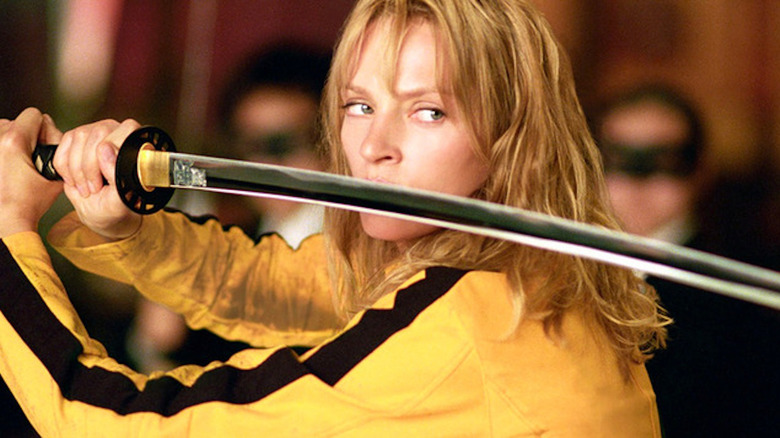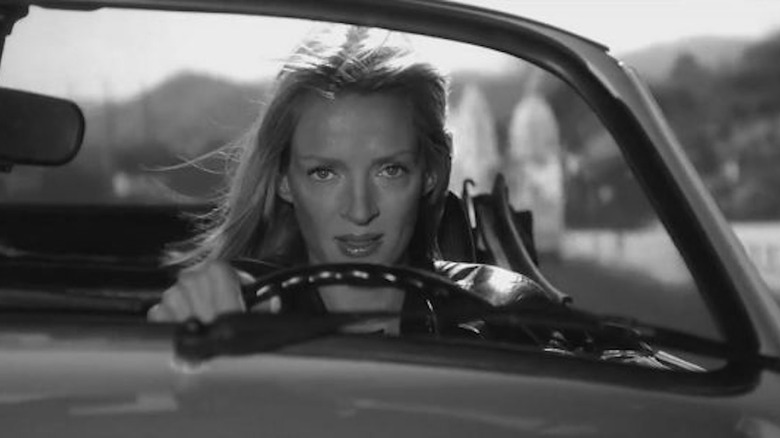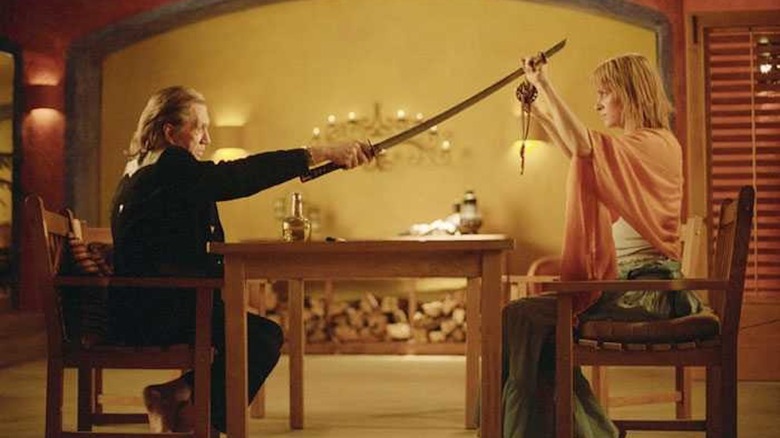A Night Out With The Pulp Fiction Crew Led To Quentin Tarantino Pitching Kill Bill
It's hard to believe, but there was a shockingly extended stretch of time when Quentin Tarantino was scrambling creatively.
His dry spell set in after the release of 1997's "Jackie Brown." Though his adaptation of Elmore Leonard's "Rum Punch" is now considered one of his finest efforts, the film was a commercial and critical comedown after the medium-altering sensation of "Pulp Fiction." It received one Academy Award nomination (Best Supporting Actor for Robert Forster) and faded from view.
Had the video-store wunderkind run out of tricks? Was he nothing more than the sum of his pop culture references and penchant for extreme, grindhouse violence?
The truth is that Tarantino knew what he wanted to do next. He just needed to step back, recalibrate, and prepare himself for an arduous, physically audacious shoot, unlike anything he'd attempted in the past. He needed to acquire a new skill set so he could do right by his leading lady, Uma Thurman, who'd co-created the project that would catapult him into the thrilling next phase of his career.
The masterpiece that begat a masterpiece
Sometimes, one brilliant turn inspires another. This was the case with the inception of "Kill Bill." The revenge epic that grew so unwieldy it had to be split into two volumes to protect Miramax's investment was born one wild night during the production of "Pulp Fiction." As Thurman told Time in 2003:
"'We were with people from the cast and crew of Pulp Fiction, just talking about revenge-genre filmmaking,' she says, 'batting ideas around.' In a matter of minutes she and Tarantino came up with a plot idea: a pregnant female assassin tries to go straight, gets viciously attacked at her wedding, loses her baby, slips into a coma, recovers and goes on a trail of revenge. Tarantino was so excited by the premise that he went home and wrote nine pages of the script in a multicolored felt-tip frenzy."
Then Tarantino's "Kill Bill" muse vanished. He lost touch with Thurman for a couple of years. When they finally reconnected, Thurman asked Tarantino if he still had the pages he'd filled in a fit of inspiration. He did, but there was no script.
On Thurman's birthday that year, he promised that she would have a completed screenplay "within weeks." A year and a half later, she, at last, received a draft of "Kill Bill."
Still waiting on 'The Whole Bloody Affair'
With Miramax's backing, Tarantino flung himself into pre-production on "Kill Bill," only to be forced to hit pause when Thurman became pregnant with her second child. The studio could've pressed him to replace Thurman, but he wouldn't hear of it. "Would Sergio Leone have replaced Eastwood in 'A Fistful of Dollars?' Would von Sternberg have replaced Dietrich in 'Morocco?' I knew how good she was going to be in this movie, so we waited."
Thank god, he did. Thurman's portrayal of Beatrix "The Bride" Kiddo resides in the pantheon of great action heroes. She dusts the best work of Wayne, Eastwood, and McQueen as a straight-up assassin who, halfway through her revenge journey, discovers her daughter is still alive. But while halving the film might've been a wise commercial decision for Miramax, it did Thurman's performance a profound disservice. "Kill Bill Volume 1" is, in the words of Sonny Chiba's Hattori Hanzo, a forest of revenge; The Bride might have her to-do list, but her bloody errand is devoid of gravity until we learn she could be reunited with her believed-dead child.
Had "Kill Bill" been released as one movie, I think Thurman would've won the Oscar for Best Actress in a walk. Hopefully, Tarantino will one day be able to release the film in its "The Whole Bloody Affair" form, at which point the filmmaker's masterpiece, and the muse who inspired it, will glory in their achievement.


